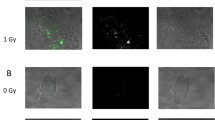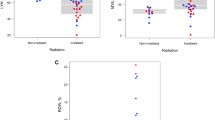Abstract
The phenomenon of delayed heritable lethal damage (often referred to as ``lethal mutations'') in the progeny of cells which survive irradiation is now well established, but little is known of the mechanism by which this cell death occurs. Current theories suggest a generalised genomic instability affecting all cells which leads to the production of some mutations which are lethal, or alternatively that a lethal mutation gene is activated, mutated or induced by radiation and leads to persistent and random cell death at high levels in the progeny. The aim of this study was to look at the morphology of progeny of irradiated cells at various times after irradiation to establish how widespread morphological abnormalities were in the population and whether there was any evidence that such abnormalities were clonal. Using two different cell lines, the results showed that morphological evidence possibly suggestive of apoptosis occurred in the cultures after all doses of radiation and up to 45 cell doublings after exposure. There was no evidence of a decrease in the numbers of damaged or dead cells in colonies with number of divisions after irradiation, or with decreasing original radiation dose. There was a significant dose-dependent increase in the number of cells with microvilli for both cell lines. The dose-dependency of this effect did not change with number of divisions after irradiation. It is clear that morphological evidence of cellular damage persists for several generations after the initial exposure. The effects are widespread in the cell population, and their constancy over time argues strongly for a general instability and against a clonal mechanism, since clonal descendants should die out and leave undamaged survivors. The lack of evidence for necrosis or senescence together with many morphological changes in the cultures suggestive of apoptosis could indicate an active mechanism of cell death. It is concluded that survivor populations of irradiated cells from two widely different mammalian cell lines demonstrate an altered phenotype including gross morphological changes. These result in a higher probability that cell division will fail to yield two healthy progeny.
Similar content being viewed by others
Author information
Authors and Affiliations
Additional information
Received: 22 January 1996 / Accepted in revised form: 24 September 1996
Rights and permissions
About this article
Cite this article
Lyng, F., O'Reilly, S., Cottell, D. et al. Persistent expression of morphological abnormalities in the distant progeny of irradiated cells. Radiat Environ Biophys 35, 273–283 (1996). https://doi.org/10.1007/s004110050040
Issue Date:
DOI: https://doi.org/10.1007/s004110050040




